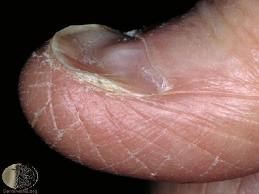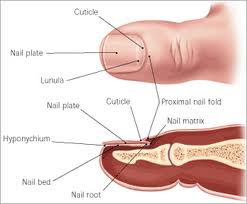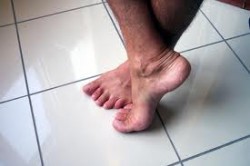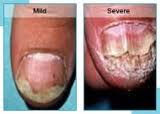Koilonychia
Koilonychia
 Koilonychia is a hereditary disorder that affects the fingernails. The nails start to get thinner and end up lifting at the outer edges, a condition more commonly known as spoon nails. This is caused by the poor absorption of iron into the bloodstream, also known as anemia.
Koilonychia is a hereditary disorder that affects the fingernails. The nails start to get thinner and end up lifting at the outer edges, a condition more commonly known as spoon nails. This is caused by the poor absorption of iron into the bloodstream, also known as anemia.
What Causes Koilonychia?
The following are common causes of Koilonychia:
- Poor circulation
- Poor Thyroid Function
- Muscle Skinning Condition
- Universal Lupus
- Hemochromatosis
- Patella Syndrome
- Reynaud’s Syndrome,
- Erythematosus
- Poor health
- Iron deficiency
- Overuse of soaps and oils
- Glossitis
- Cheilosis
- Pica
- Undernourishment
Symptoms and Solutions
Koilonychia is a symptom of anemia and/or iron deficiency. It needs to be caught quickly once the visual symptoms have shown. Granted, spoon nails can also be caused by worrying the edge of the nail, causing them to detach from the nail bed and curl up. However there are many ways that Koilonychia can be prevented.
- Wear protective covering on your hands while washing dishes or immersing your hands in liquid for a long period of time.
- Don’t bite your nails as this can cause irritation and inflammation to the nail bed
- Obtain proper nourishment whenever possible
- Take vitamin supplements
- Work with your doctor to identify the cause of your anemia and supplement your diet accordingly.
- Don’t eat or drink things that cause your system to shed iron, for instance, caffeinated beverages slow down iron absorption.
- Take vitamin C and Iron supplements to increase healthy nail growing capacity.
Treatment usually consists of taking an iron supplement once or twice a day, and/or increasing the iron rich foods in the affected patient’s diet. The intestinal system may or may not allow the full absorption of the increased iron dosage, depending on the person.
What You Need To Know About Toenail Fungus
What You Need To Know About Toenail Fungus
 Toenail fungus infections are all caused by a fairly common set of conditions that can affect up to 12% of the American population. A fungus is a living organism that enjoys dark, damp places. Because of this, most people get a fungal nail infection in their toes. It does sometimes occur on fingernails, but as the feet offer a much more hospitable environment, that is the most sought after area for these little life-forms. The fungus can live along side the nail, or burrow underneath the nail. There are several factors that determine where the infection is actually located, two of which are the progression and severity of the infection.
Toenail fungus infections are all caused by a fairly common set of conditions that can affect up to 12% of the American population. A fungus is a living organism that enjoys dark, damp places. Because of this, most people get a fungal nail infection in their toes. It does sometimes occur on fingernails, but as the feet offer a much more hospitable environment, that is the most sought after area for these little life-forms. The fungus can live along side the nail, or burrow underneath the nail. There are several factors that determine where the infection is actually located, two of which are the progression and severity of the infection.
Doctors have noticed that a the beginning of an occurrence, it is most likely that the fungus lives along side the nail and gradually works its way underneath the nail to the nail bed as the infection progresses. Early symptoms of a fungal nail infection include a white or yellowish spot on the nail. As pain or discomfort are not common at this stage of infection, most people don’t notice the problem until it has progressed further.
As the infection develops, things become a bit more noticeable, even if these changes happen slowly. The nail dulls and gradually becomes yellowed and sometimes the toenail changes its shape. This is caused by the thickening of the nail and potential crumbling at the edges as it becomes more brittle and frail. The thick, yellowing, ridged nail is the trademark of the condition. This is when people tend to feel discomfort from the infection, sometimes caused by the nail separating from the nail bed.
If you allow this condition to progress sufficiently that your toenail separates from the nail bed, exposing the soft skin below, it is possible that this can result in further, and more serious, infection. If you see pus oozing from your toe, or if there is a bad odor when you take off your sock, it is now time to go see your doctor, immediately.
The myth about the toenail fungus microorganism is that it is only found in dirty places. Much like its cousin, the mushroom, this microorganism is happy to breed wherever and whenever it can. If its living conditions are correct, it will be there and will inevitably come into contact with hands and feet that it will send its spores onto to continue increasing the population. This is a fungus that everyone comes into contact with daily. Infection occurs when you give the fungus an environment in which it can thrive.
The medical community refers to this particular fungus as dermatophytes. While there are other causes of nail fungus infection, including yeast and mold, dermatophytes are the most common culprit.
There are things that may make a person more susceptible to toenail fungus, such as:
- An unhealthy immune system
- Peripheral artery disease
- Trauma to the foot, especially if the toenail has been damaged
- Abnormal skin pH
- Poor hygiene
- Previous fungal nail infections
It is unlikely that a fungal nail infection will become life threatening or debilitating. However they can cause pain and discomfort as well as affect a person’s self esteem because of the appearance of the nail. Because treating toenail fungus can be difficult, doing your best to prevent infection is the most effective cure. If you are concerned that you have an infected toenail, consult with your health care provider. Between the two of you, the state of your foot health can be determined and a course of action can be enacted.
The Places Toenail Fungus Like To Hide
The Places Toenail Fungus Like To Hide
 Permanently ridding yourself of a nail fungus infection once it has taken hold can be a very difficult job. The fungus grows slowly but strongly and by the time you see the initial symptoms, a great deal of damage has already occurred. The fungus likes to work its way underneath the nail so that it uses the nail as a shield to keep it warm and moist, its favorite growing environment. It also makes it easier for the infection to reoccur after what seems like successful treatment because the fungus can lie dormant underneath the nail, then start growing again once the treatment ceases.
Permanently ridding yourself of a nail fungus infection once it has taken hold can be a very difficult job. The fungus grows slowly but strongly and by the time you see the initial symptoms, a great deal of damage has already occurred. The fungus likes to work its way underneath the nail so that it uses the nail as a shield to keep it warm and moist, its favorite growing environment. It also makes it easier for the infection to reoccur after what seems like successful treatment because the fungus can lie dormant underneath the nail, then start growing again once the treatment ceases.
How Does a Nail Fungus Grow?
A fungus is a parasitic growth that prefers darkness to sunlight, as it has no chlorophyll. It does have roots and spreads via spores. Much like its cousin the mushroom, the body of the fungus looks like an umbrella. The spores spread and grow in dark, damp places. The most common cause of toenail fungus is wearing shoes as they hold in the moisture of sweat and keep the toenails in the dark. Also, most people wear the same pair of moisture absorbing shoes over and over again without allowing them to dry and air properly. Your body gives off both moisture and heat, providing the fungus with the perfect living environment.
Besides Shoes, Where Else Do Fungus Hide?
Exercise mats, such as yoga mats are ideal breeding grounds for the spores that cause nail fungus. Although the mat is made of rubber, which you would think is impenetrable, it soaks up the heat and moisture while you exercise. Then after your workout, you roll it up and stick it away until next time, providing the perfect growing environment for the fungus to attack your feet.
Flip-Flops that people wear into public showers are another good breeding ground for fungus, especially because most people don’t allow them to dry thoroughly before using them again. Ironically, the very item you use to protect your feet becomes the transmitter for the fungus you are trying to avoid.
Remedies To Treat Nail Fungus
There are many ointments and nail fungus solutions available over the counter or on the Internet to clear up nail fungus infections.
Most people try these, or home remedies before resorting to taking an oral antifungal medication to clear up the fungal nail infection as there are risky side effects associated with these treatments.
Mixing Tea Tree Oil and mineral oil as a toe soak is a home remedy solution. The mineral oil works to soften both the nail and surrounding skin, the Tea Tree Oil is a natural antifungal and antiseptic. Combined, these can be a powerful treatment for your nail fungus problem. This, and all nail fungus treatments, will take a while to show results and to cure the problem permanently, so you have to be patient and practice these remedies regularly so the full healing process can take place.
Available Prescription Medication for Fungal Toenail Infections
Available Prescription Medication
for Fungal Toenail Infections
 Antifungal medications are most commonly used to treat toenail fungus infections. These are normally oral prescription medications and unfortunately have a long list of potential risks and side effects. There are topical fungicides that are prescription strength and available on advice of your doctor. Both kinds of medication require a treatment regimen of 12 weeks for toenail fungus and 6 weeks for fingernail fungus. The length of treatment can vary with the severity of the infection.
Antifungal medications are most commonly used to treat toenail fungus infections. These are normally oral prescription medications and unfortunately have a long list of potential risks and side effects. There are topical fungicides that are prescription strength and available on advice of your doctor. Both kinds of medication require a treatment regimen of 12 weeks for toenail fungus and 6 weeks for fingernail fungus. The length of treatment can vary with the severity of the infection.
Curing a toenail fungus infection can be very difficult and time consuming. Before you and your doctor agree on a treatment, it must be determined what kind of fungal infection you are suffering from. Once this is established, your doctor will prescribe a medication to eliminate the fungus. This is where you need to be educated and verbose. You need to tell your doctor about all of the medications you are taking, including supplements and herbal remedies. The prescriptions available to cure fungal nail infections are very hard on the system and can cause serious drug interactions.
Lamisil (otherwise known as terbinafine) is the most popular medication used to treat fungal infections. This medicine is most effective for dermatophytic infection. Lamisil is prescribed at 250 mg per day for 6-12 weeks. Another component of this medication is numerous blood tests to ensure that your liver is healthy enough to follow this regimen and that no damage is occurring during the treatment cycle. This makes this particular treatment very expensive. An initial baseline test will be done to determine your liver health before you start treatment. During treatment, your doctor will require that you visit the office and may order blood tests throughout the treatment at random, or regular intervals. This is done because Lamisil is processed by the liver and there is the potential for several rare hepatic side effects, including hepatitis, blood dyscrasias and Stevens-Johnson syndrome. Following your doctor’s recommendations can protect you from serious liver damage over the course of your treatment.
Another well known antifungal used to treat toenail infections is Diflucan (or fluconazole) Diflucan is most commonly used to treat yeast infections.
Both of these medications can be found in their generic form at pharmacies all over the country for about $4.00 Numerous pharmacies, including Target, Wal-Mart and Publix offer prescription drugs at a discounted rate. Please note, you must have a doctor’s prescription to acquire these medications. If you need to take these drugs for an extended period, it may be worth the effort to research which pharmacies offer this program.
Other medications commonly used to treat toenail fungus infections are:
- Ciclopirox (commercial name – Penlac) a topical nail lacquer used to infuse the nail with medication
- Itraconazole (commercial name – Sporanox) is a newer medication and works similarly to Lamisil
- Griseofulvin is an older drug and is no longer regularly prescribed due to its lack of efficacy
- Ketoconazole (commercial name – Nizoral) although very effective at eliminating fungus, is not prescribed often because of the high risk of hepatotoxicity.
You and your doctor can work together to find the best antifungal treatment to cure your toenail fungus. The most important part of your treatment will be discouraging the growth of fungus on your own by making sure that your feet are clean, dry and surrounded by breathable materials so that you are not offering a hospitable environment. By following this simple advice, you are much more likely to find yourself fungus free at the end of your treatment.
Common Nail Fungus Symptoms and Solutions
Common Nail Fungus Symptoms and Solutions
 Suffering from some form of nail fungus is very common in humans. Because we find this embarrassing, we tend to hide the infected nail from view. This is especially true with toenails as they are easiest to hide inside a stuffy, warm set of shoes and socks.
Suffering from some form of nail fungus is very common in humans. Because we find this embarrassing, we tend to hide the infected nail from view. This is especially true with toenails as they are easiest to hide inside a stuffy, warm set of shoes and socks.
Solving this problem can be both easier, and more difficult than you think. There are many products available to cure nail fungus. However some of them include some risk of further problems, some don’t and will never work, and some people just have the problem of poor health that leads to continued infection.
What Causes Nail Fungus?
Every day we encounter many different microbes, microorganisms and bacterial. This is a normal part of life. Some of these turn out to be nail fungus spores. Most of the time, these are harmless as they are easily washed away. But if they manage to get into or under your nails, then they become problematic.
When the spore gets itself into a warm, dark, moist place on your body (most commonly your nails because they have that extra benefit of being a good shield from the world) they are able to grow and multiply, causing that nasty look of yellowing and thickness everyone associates with a nail fungus infection.
As the invasion by the fungus develops, so do the symptoms of nail fungus infection. The nail begins to become disfigured and can even get to the point where it crumbles or flakes away. This is most common in toenails because they spend so much time wrapped in socks and shoes, which creates a great breeding environment for the fungus.
How Do I Treat a Nail Fungus Infection?
There are several natural remedies available, as well as many home remedies that are recommended before you try the more aggressive method of taking an oral antifungal medication, which carries the risk of damage to your liver. Here are some suggestions:
• Tea Tree Oil – This natural essential oil is available at most health food stores. Rub the oil into the nail and surrounding skin a few times a day. Its antifungal properties will eventually kill the fungus
• Good Nail Hygiene – Keep your nails short, right at the edge of the toe and clean out the underside with a nail file to ensure no dirt is able to permanently lodge there. Keep your feet clean and dry and air them as much as possible by not wearing closed shoes.
• Vinegar – Soak your toes in a solution of vinegar and water, then wash and dry them thoroughly. The vinegar changes the pH of the growing environment, making it uninhabitable for the fungus.
If you have tried these solutions, and/or some of the others out there and nothing seems to make the nail fungus infection go away permanently, your next step is to consult with your health care professional to find a more standard medical solution to the problem. Be aware that some of these prescription solutions do carry risks so be sure to discuss this with your doctor and to make your doctor aware of all medications your are currently taking. During your treatment, continue to practice good nail hygiene as this will encourage the healing process and help to prevent spreading or continued nail fungus infection of your toenails.
Many solutions are available to treat this problem. Search the internet for alternatives before you commit yourself to taking an oral antifungal medication, especially if a child is the infected patient. If you do your research it will pay off in the long run.